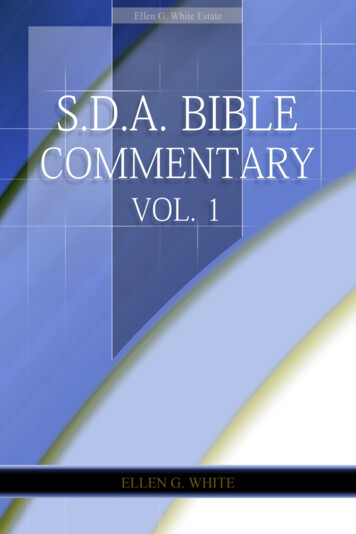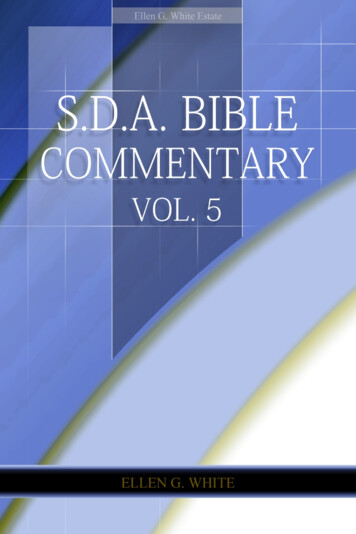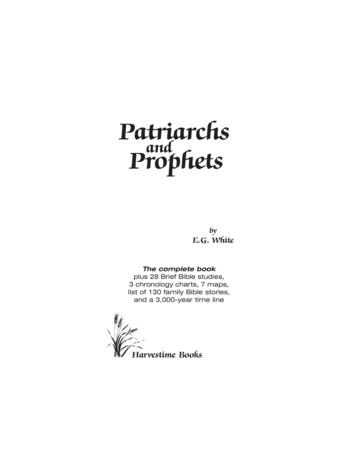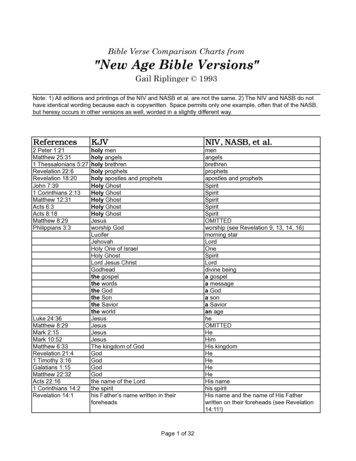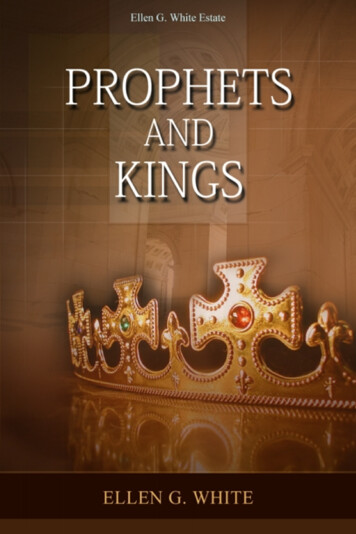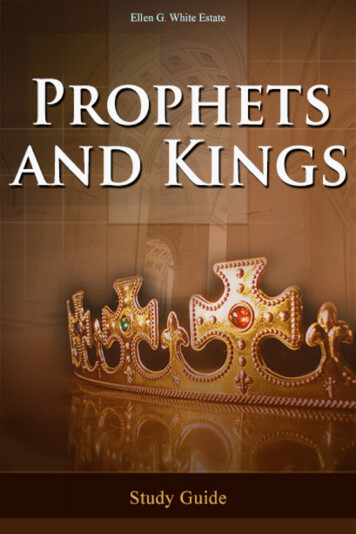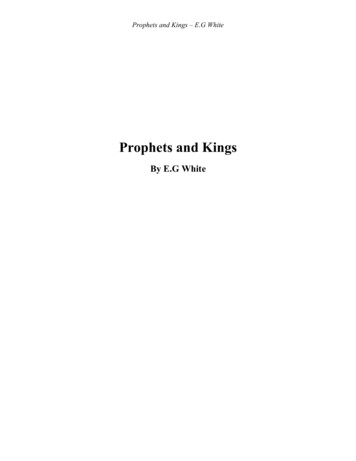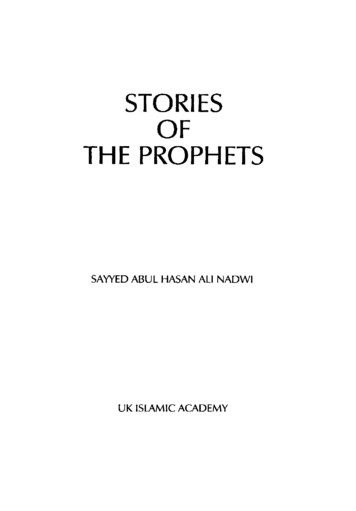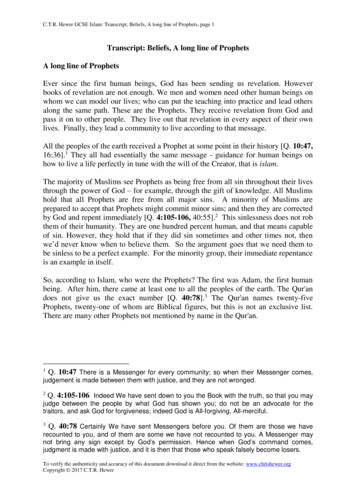
Transcription
Patriarchs and Prophets-- Study GuideEllen G. White Estate2019Copyright 2021Ellen G. White Estate, Inc.
Information about this BookOverviewThis eBook is provided by the Ellen G. White Estate. It is includedin the larger free Online Books collection on the Ellen G. WhiteEstate Web site.About the AuthorEllen G. White (1827-1915) is considered the most widely translatedAmerican author, her works having been published in more than 160languages. She wrote more than 100,000 pages on a wide variety ofspiritual and practical topics. Guided by the Holy Spirit, she exaltedJesus and pointed to the Scriptures as the basis of one’s faith.Further LinksA Brief Biography of Ellen G. WhiteAbout the Ellen G. White EstateEnd User License AgreementThe viewing, printing or downloading of this book grants you onlya limited, nonexclusive and nontransferable license for use solelyby you for your own personal use. This license does not permitrepublication, distribution, assignment, sublicense, sale, preparationof derivative works, or other use. Any unauthorized use of this bookterminates the license granted hereby. (See EGW Writings End UserLicense Agreement.)Further InformationFor more information about the author, publishers, or how youcan support this service, please contact the Ellen G. White Estatei
at mail@whiteestate.org. We are thankful for your interest andfeedback and wish you God’s blessing as you read.ii
ContentsInformation about this Book . . . . . . . . . . . . . . . . . . . . . . . . . . . . . . iChapter 1: Why Was Sin Permitted? . . . . . . . . . . . . . . . . . . . . . . . . 6Chapter 2: The Creation . . . . . . . . . . . . . . . . . . . . . . . . . . . . . . . . . . 7Chapter 3: The Temptation and Fall . . . . . . . . . . . . . . . . . . . . . . . . 8Chapter 4: The Plan of Redemption . . . . . . . . . . . . . . . . . . . . . . . . 9Chapter 5: Cain and Abel Tested . . . . . . . . . . . . . . . . . . . . . . . . . 10Chapter 6: Seth and Enoch . . . . . . . . . . . . . . . . . . . . . . . . . . . . . . . 11Chapter 7: The Flood . . . . . . . . . . . . . . . . . . . . . . . . . . . . . . . . . . 12Chapter 8: After the Flood . . . . . . . . . . . . . . . . . . . . . . . . . . . . . . 13Chapter 9: The Literal Week . . . . . . . . . . . . . . . . . . . . . . . . . . . . 14Chapter 10: The Tower of Babel . . . . . . . . . . . . . . . . . . . . . . . . . 15Chapter 11: The Call of Abraham . . . . . . . . . . . . . . . . . . . . . . . . 16Chapter 12: Abraham in Canaan . . . . . . . . . . . . . . . . . . . . . . . . . . 17Chapter 13: The Test of Faith . . . . . . . . . . . . . . . . . . . . . . . . . . . 18Chapter 14: Destruction of Sodom . . . . . . . . . . . . . . . . . . . . . . . 19Chapter 15: The Marriage of Isaac . . . . . . . . . . . . . . . . . . . . . . . 20Chapter 16: Jacob and Esau . . . . . . . . . . . . . . . . . . . . . . . . . . . . . . 21Chapter 17: Jacob’s Flight and Exile . . . . . . . . . . . . . . . . . . . . . 22Chapter 18: The Night of Wrestling . . . . . . . . . . . . . . . . . . . . . . 23Chapter 19: The Return to Canaan . . . . . . . . . . . . . . . . . . . . . . . 24Chapter 20: Joseph in Egypt . . . . . . . . . . . . . . . . . . . . . . . . . . . . 25Chapter 21: Joseph and His Brothers . . . . . . . . . . . . . . . . . . . . . 26Chapter 22: Moses . . . . . . . . . . . . . . . . . . . . . . . . . . . . . . . . . . . . . 27Chapter 23: The Plagues of Egypt . . . . . . . . . . . . . . . . . . . . . . . . 28Chapter 24: The Passover . . . . . . . . . . . . . . . . . . . . . . . . . . . . . . . 29Chapter 25: The Exodus . . . . . . . . . . . . . . . . . . . . . . . . . . . . . . . . 30Chapter 26: From the Red Sea to Sinai . . . . . . . . . . . . . . . . . . . . . 31Chapter 27: The Law Given to Israel . . . . . . . . . . . . . . . . . . . . . 32Chapter 28: Idolatry at Sinai . . . . . . . . . . . . . . . . . . . . . . . . . . . . 33Chapter 29: Satan’s Enmity Against the Law . . . . . . . . . . . . . . . 34Chapter 30: The Tabernacle and Its Services . . . . . . . . . . . . . . . 35Chapter 31: The Sin of Nadab and Abihu . . . . . . . . . . . . . . . . . 36Chapter 32: The Law and the Covenants . . . . . . . . . . . . . . . . . . . 37Chapter 33: From Sinai to Kadesh . . . . . . . . . . . . . . . . . . . . . . . 38iii
ivChapter 34:Chapter 35:Chapter 36:Chapter 37:Chapter 38:Chapter 39:Chapter 40:Chapter 41:Chapter 42:Chapter 43:Chapter 44:Chapter 45:Chapter 46:Chapter 47:Chapter 48:Chapter 49:Chapter 50:Chapter 51:Chapter 52:Chapter 53:Chapter 54:Chapter 55:Chapter 56:Chapter 57:Chapter 58:Chapter 59:Chapter 60:Chapter 61:Chapter 62:Chapter 63:Chapter 64:Chapter 65:Chapter 66:Chapter 67:Chapter 68:Chapter 69:Chapter 70:Chapter 71:Patriarchs and Prophets -- Study GuideThe Twelve Spies . . . . . . . . . . . . . . . . . . . . . . . . . . .The Rebellion of Korah . . . . . . . . . . . . . . . . . . . . . .In the Wilderness . . . . . . . . . . . . . . . . . . . . . . . . . . . .The Smitten Rock . . . . . . . . . . . . . . . . . . . . . . . . . .The Journey Around Edom . . . . . . . . . . . . . . . . . . .The Conquest of Bashan . . . . . . . . . . . . . . . . . . . . .Balaam . . . . . . . . . . . . . . . . . . . . . . . . . . . . . . . . . . .Apostasy at the Jordan . . . . . . . . . . . . . . . . . . . . . . .The Law Repeated . . . . . . . . . . . . . . . . . . . . . . . . . . .The Death of Moses . . . . . . . . . . . . . . . . . . . . . . . . .Crossing the Jordan . . . . . . . . . . . . . . . . . . . . . . . . .The Fall of Jericho . . . . . . . . . . . . . . . . . . . . . . . . . .The Blessings and the Curses . . . . . . . . . . . . . . . . . .League With the Gibeonites . . . . . . . . . . . . . . . . . .The Division of Canaan . . . . . . . . . . . . . . . . . . . . . .The Last Words of Joshua . . . . . . . . . . . . . . . . . . . .Tithes and Offerings . . . . . . . . . . . . . . . . . . . . . . . . .God’s Care for the Poor . . . . . . . . . . . . . . . . . . . . . .The Annual Feasts . . . . . . . . . . . . . . . . . . . . . . . . . . .The Earlier Judges . . . . . . . . . . . . . . . . . . . . . . . . . .Samson . . . . . . . . . . . . . . . . . . . . . . . . . . . . . . . . . . .The Child Samuel . . . . . . . . . . . . . . . . . . . . . . . . . .Eli and His Sons . . . . . . . . . . . . . . . . . . . . . . . . . . . . .The Ark Taken by the Philistines . . . . . . . . . . . . . .The Schools of the Prophets . . . . . . . . . . . . . . . . . .The First King of Israel . . . . . . . . . . . . . . . . . . . . . .The Presumption of Saul . . . . . . . . . . . . . . . . . . . . .Saul Rejected . . . . . . . . . . . . . . . . . . . . . . . . . . . . . .The Anointing of David . . . . . . . . . . . . . . . . . . . . . . .David and Goliath . . . . . . . . . . . . . . . . . . . . . . . . . .David a Fugitive . . . . . . . . . . . . . . . . . . . . . . . . . . . .The Magnanimity of David . . . . . . . . . . . . . . . . . . .The Death of Saul . . . . . . . . . . . . . . . . . . . . . . . . . . .Ancient and Modern Sorcery . . . . . . . . . . . . . . . . .David at Ziklag . . . . . . . . . . . . . . . . . . . . . . . . . . . . .David Called to the Throne . . . . . . . . . . . . . . . . . . .The Reign of David . . . . . . . . . . . . . . . . . . . . . . . . .David’s Sin and Repentance . . . . . . . . . . . . . . . . . 364656667686970717273747576
ContentsvChapter 72: The Rebellion of Absalom . . . . . . . . . . . . . . . . . . . . 77Chapter 73: The Last Years of David . . . . . . . . . . . . . . . . . . . . . 78
Chapter 1: Why Was Sin Permitted?1. In heaven, Lucifer began to insinuate doubts concerning God’slaw that governed the angels. How does he continue to attack God’slaw?2. What steps did Lucifer take that caused a spirit of dissatisfaction to grow among the angels? How did the loyal angels respondduring this time?3. The counsel and entreaties of the loyal angels opened a doorof hope to the angels blinded by Satan’s deceptions; had they heeded,they might have broken away from his snares. How does this encourage you to witness to those who seem to have fallen beyondhope?4. Why did God not destroy Satan, but see fit to allow sin to runits course?6
Chapter 2: The Creation1. What is the significance of Eve’s being created from a ribtaken from Adam’s side? Read Ephesians 5:29. What is to be therelationship between husband and wife?2. Marriage “was one of the first gifts of God to man, and it isone of the two institutions that, after the Fall, Adam brought withhim beyond the gates of Paradise.” What was the other institution?3. Even in Paradise, the Sabbath was essential for man. Whatpurposes does the Sabbath serve? How should we observe this holyday?4. Read 1 Thessalonians 4:11, 12. Those who regard work as acurse are cherishing an error. What should be our attitude towardwork?7[4]
[5]Chapter 3: The Temptation and Fall1. The enemy tempted Eve to disobey God by leading her tobelieve she would enter a higher sphere of existence and broaderfield of knowledge. In what respect did this come true?2. How did the spirit of self-justification manifest itself after thefall of humanity? How can you avoid falling into the same trap?3. Romans 6:23 says: “The wages of sin is death.” How is God’swisdom and justice in His dealings with humanity revealed in thisverse?8
Chapter 4: The Plan of Redemption1. In what ways was the sacrificial system symbolic of the workof Christ?2. Why did God wait four thousand years to make His sacrificefor our salvation?3. The greatest benefit of the plan of salvation is providingeternal life for us in heaven. What other benefits or purposes wereserved both here and throughout the universe?4. How can we help the lost experience the joy of redemption?If you have not yet asked Jesus into your heart, stop right now andsay this prayer: “Dear Jesus. I know I’m a sinner. I’ve really made amess of my life. I accept Your death on the cross as the only meanswhereby I can enjoy forgiveness and eternal life. Forgive me, now,and mold me so I can be what you want me to be. Make me readyto live with You in heaven. I love You. Amen.”9[6]
[7]Chapter 5: Cain and Abel Tested1. Compare and contrast the characters of Cain and Abel. Howdid God show mercy to Cain?Patriarchs and Prophets Study Guide2. How is Abel a symbol of Christ? Why is God particular abouthow we worship Him?3. The inhabitants of unfallen worlds watched the actions ofCain and Abel. How should knowing the universe is watching usaffect our behavior?10
Chapter 6: Seth and Enoch1. Contrast the descendants of Cain with the descendants ofSeth.2. How can we be like Seth and lead a line of righteous generations?3. How is death actually a blessing on a fallen world?4. “Enoch walked with God” (Genesis 5:22, 24). In what wayscan we walk with God as did Enoch?11[8]
[9]Chapter 7: The Flood1. Read Psalm 115:2-8 and Exodus 20:4-6. What was one ofthe great sins of the antediluvian world? What result did its practicehave on human minds?2. Read 2 Peter 1:5-8 and Ephesians 6:10-18. Amusement andpleasure-seeking caused indifference toward God in the antediluvianworld. How can you avoid this indifference in your life?3. Read Ecclesiastes 12:13; Acts 16:31; Romans 2:13. Noahpreached for 120 years, yet of the vast population of the earth beforethe flood only eight souls were saved. What made the difference inthose eight lives that can make a difference in yours?12
Chapter 8: After the Flood1. Although the face of the earth was dry, Noah still waitedpatiently within the ark. Read James 1:3, 4. What relationship existsbetween faith and patience?2. We admire the rainbow for its beauty, yet what true purposeis it to serve? To what does the rainbow testify from generation togeneration?3. In what ways was the earth changed after the flood? ReadRevelation 21:1-5. Will the earth ever return to its original state? Ifso, when?4. God can preserve the righteous in times of turmoil. Describedways and instances in which God has protected and preserved youduring times of trouble in your life.13[10]
[11]Chapter 9: The Literal Week1. Why are Satan’s special attacks directed against the fourthcommandment? What event does that commandment commemorate?2. Nature is a servant of her Creator. In what ways did Christdefy the laws of nature, as understood by humanity, in the followingpassages: Matthew 8:23-27; 14:22-33?3. How do the following verses reveal God’s sustaining power innature? Who is the instrument of this sustaining power: Colossians1:16-18; Hebrews 1:1-3?14
Chapter 10: The Tower of Babel1. Compare the world after the flood with the world before theflood.2. Confounding humanity’s languages would slow the advanceof evil, but also make it more difficult for people to learn of God’struth. Why, then, would God resort to such an action?3. There is much discussion in society about the benefits ofhaving a united world government. What are the dangers of havinga united world government on a sinful planet?15[12]
Chapter 11: The Call of Abraham[13]1. Describe the spiritual environment in which Abraham grewup.2. How did the story of Abraham’s sojourn in Egypt provide encouragement to the Israelites in their sojourn there several centurieslater?3. One of the first things to happen to Abraham after reachingCanaan was a famine that tested his character. How might God testour characters after calling us to serve Him?16
Chapter 12: Abraham in Canaan1. Contrast the characters of Abraham and Lot.2. What are some examples of Abraham’s strong character during the dispute between his herdsmen and Lot’s? How did Abrahamhandle the dispute among his herdmen and those of Lot’s? Whatlessons about conflict resolution can be gained from Abraham’smethods?3. What is the spiritual meaning of “circumcision”?4. Lot foolishly endangered himself by living among the sinnersof Sodom. Why was Abraham willing on one occasion to riskhimself to rescue Lot, and on another to intercede on his behalf?17[14]
[15]Chapter 13: The Test of Faith1. What were the negative consequences of Abraham’s takingHagar as a second wife?2. Why did God aid and bless Ishmael, though he was not theson of promise?3. Abraham fathered a son through Hagar when it seemed thatGod would not provide a child any other way. Have you ever “runahead of God” when He did not seem to provide?4. In Genesis 22, Abraham was called to sacrifice Isaac, whomhe loved dearly. Why does God at times ask us to sacrifice what ismost dear to us?18
Chapter 14: Destruction of Sodom1. Describe the last night in Sodom before God destroyed thecity.2. Lot’s wife looked back, showing that her heart was still inSodom. How can we be like Lot’s wife and “look back”?3. Abraham and Lot showed hospitality to strangers. In whatways can we show hospitality to others?19[16]
[17]Chapter 15: The Marriage of Isaac1. Compare Rebekah’s character with Abraham’s?2. There is more to a good wife than physical beauty. Why, then,do you think the Bible highlights that Rebekah was beautiful?3. Rebekah offered to water Eliezer’s camels. How did Rebekah’s behavior send a signal to Eliezer that she was the idealcandidate to be Isaac’s wife?4. What can we learn from this story about how one should seeka godly spouse?20
Chapter 16: Jacob and Esau1. Contrast the characters of Jacob and Esau. Compare the storyof Jacob and Esau with the story of Cain and Abel.2. What was wrong with Esau’s decision to marry Canaanitewomen?3. Esau, in selling his birthright, showed greater interest in satisfying his immediate appetite than in obtaining his future, spiritualrewards. What lessons can we learn regarding the power of theappetite?4. Can you think of a situation where you, like Jacob, mightresort to evil to bring about God’s plan? How might God providefor you if you remain faithful and wait for things to change with Histiming?21[18]
[19]Chapter 17: Jacob’s Flight and Exile1. How was the dream of a ladder extending from heaven toearth a comfort to Jacob? How was Jacob’s ladder a type of Christ?2. Read Genesis 27 and 29. Think of the trials that Jacob enduredafter deceiving his father. Compare Jacob’s stealing of the blessingwith Laban’s deceit of giving Leah rather than Rachel to Jacob. Whattrials might one face as a result of practicing deceit?3. Why was it important for God to renew His covenant withAbraham, with Isaac and Jacob?4. Jesus is like a shepherd in His care and providence for us.How is He a shepherd to you?22
Chapter 18: The Night of Wrestling1. Why was Jacob afraid to meet Esau?2. Contrast the character of Jacob before and after wrestling withthe angel. Why did God choose to wrestle with Jacob? Was therea reason that God wanted Jacob to be disabled when he faced hisbrother? In what ways do you wrestle with God?3. God worked to reunite Jacob and Esau. How does Christcontinue to work to reconcile distanced family members?23[20]
[21]Chapter 19: The Return to Canaan1. Does a difficult life always indicate that we are living outsideof God’s will for our lives, while a prosperous life show that we areliving out God’s will for us? Is financial or business success alwaysan indicator of God’s favor? Is popularity? Is peace? Explain youranswer.2. What are some of the character traits that Joseph was knownfor in his youth?3. Consider the life experiences of Esau, Jacob, Reuben, andJoseph. When is a good time to begin developing a character that isnoble and Christlike? How much does a person’s habitual characterinfluence the turns his or her life may take?24
Chapter 20: Joseph in Egypt1. Joseph’s journey to Egypt was particularly painful and bitterfor him. Then, even after working faithfully, he was put in jailfor a crime he did not commit. How did the trials of being soldinto slavery, being separated from his father, and being wronglyimprisoned affect Joseph? What lessons did he learn from theseexperiences?2. Joseph, surrounded by a culture that did not worship his God,was faced with temptations to stray from the moral code of his childhood. How did Joseph respond to the culture around him when itcontradicted with what he believed about God and His expectations?3. Read Genesis 50:20 and Romans 8:28. God worked out thecircumstances in Joseph’s life for the good not only of Joseph butalso for his family and the nations surrounding Egypt. Do you havefaith in the ability of Jesus to work this way in your life?25[22]
[23]Chapter 21: Joseph and His Brothers1. Why did Joseph feel that it was important to test his brothersbefore he revealed his identity to them?2. What about Joseph’s brothers’ behavior convinced him thatthey had changed for the better?3. How does being forgiven affect the way that you relate to theone who forgave you? (Look at the relationship of Joseph and hisbrothers as they were forgiven and began to trust one another again.)4. How is the way that Joseph dealt with his brothers similarto the way that God deals with us? Consider the gifts that Josephoffered to his brothers: forgiveness (Genesis 45:3-5), comfort (Genesis 50:19-21), and an invitation to live with him so he could providefor all his family’s needs (Genesis 45:9-11). Compare these giftswith what Jesus offers us (Matthew 18:21-22; Romans 8:28; John14:1-3).26
Chapter 22: Moses1. How did Satan try to thwart God’s plans to deliver Israel frombondage?2. In what respects is the experience of Moses similar to that ofJesus’?3. Why would God use a burning bush to call Moses? What aresome of the ways that God makes Himself known to us?4. Consider how Moses’ parents prepared him for life in theEgyptian court. What are some ways in which parents can help toprepare their children to live godly lives in a worldly society?27[24]
[25]Chapter 23: The Plagues of Egypt1. Contrast Moses’ character in Egypt with his character afterhis years of service as a shepherd.2. How did the Israelites respond to Moses when he returned toEgypt to deliver them?3. Moses’ mission was to work for the complete freedom ofIsrael. Why, then, would he simply ask Pharaoh to allow the peopleto take a three-day journey into the wilderness?4. Why would Pharaoh allow his heart to harden so that he wouldrather lead his nation to ruin than obey God?28
Chapter 24: The Passover1. Contrast Pharaoh’s response to the tenth plague with hisresponse when Moses first met with him and called for him to freethe Israelites.2. What was the significance of God’s smiting the firstborn?3. How was the deliverance from Egypt a symbol of the work ofChrist?29[26]
[27]Chapter 25: The Exodus1. How did God show His power to the Egyptians at the Red Seabefore destroying them?2. Why did the Egyptians claim that God’s miraculous acts weremerely the result of natural events?3. In what way is the Exodus a symbol of the final deliveranceat the end of the world?4. In Exodus 15, Moses and Miriam sang songs to celebrateGod’s deliverance. What are some songs you might sing to praiseGod for His acts of deliverance?30
Chapter 26: From the Red Sea to Sinai1. How did God miraculously provide for the Israelites in thewilderness?2. Why did God make the manna fade away in the sunlight? DoesGod provide for us on a daily basis as He did with the Israelites?3. Exodus 17 tells how Aaron and Hur supported Moses’ armsso he could keep them raised during the battle. How can we be likeAaron and Hur and support our leaders in their battles?31[28]
[29]Chapter 27: The Law Given to Israel1. How is God’s love clearly seen in the way He gave the TenCommandments?2. Why was Moses able to speak with God while the Israeliteswere not?3. What is the significance of God’s writing the Ten Commandments with His finger?4. Read Genesis 1. When God spoke, everything happened asHe commanded. What is the way we should live so God’s commandments will be expressed in our lives?32
Chapter 28: Idolatry at Sinai1. What two activities, if they had done them, would haveshielded the Israelites from temptation while Moses was on themountain?2. How could Aaron have changed the course of the Israelites’sinful behavior at Sinai? What lesson does this provide for leadersin the church today?3. How did the punishment meted out on the Israelites at Sinaishow God’s love and mercy as well as His justice?4. Even though the Israelites had committed a terrible sin againstGod, He spared those who repented. Read 1 John 1:9 and Hebrews10:19-23. What action should we take when we have done wrong?33[30]
[31]Chapter 29: Satan’s Enmity Against the Law1. Through what plan is it possible for a person to live in harmonywith God, and to His law? Explain.2. What was Satan’s ultimate purpose in leading the Israelitesinto idolatry at Sinai?3. If the Sabbath had always been sacredly observed, what wouldhave been the4. What will be the role of God’s law in the earth made new?34
Chapter 30: The Tabernacle and Its Services1. How did the breastplate of the high priest represent Christ’swork for us?2. What did the ascending incense represent, and how did itfunction?3. Read Leviticus 4. What two similar ceremonies symbolizedthe transfer of sin sanctuary?4. How did the Day of Atonement show that justice will eventually be completed? be afraid of that Day?35[32]
[33]Chapter 31: The Sin of Nadab and Abihu1. Contrast God’s holy fire with the “strange” fire offered byNadab and Abihu.2. Why is it significant that God would judge Nadab and Abihuwith punishment by fire?3. Nadab and Abihu were spiritually impaired by alcohol whenthey sinned. What are other ways in which judgment may be impaired?36
Chapter 32: The Law and the Covenants1. Compare God’s spiritual laws with the physical laws Heordained to govern nature.2. Contrast the moral law with the ceremonial law.3. How is Christ’s character shown through the law?4. Much is said about the power of God’s grace to forgive andprovide. What is the place of God’s law in our lives?5. Israel was blessed with a covenant relationship with God.What are some ways that we can benefit from being in a covenantrelationship with God?37[34]
[35]Chapter 33: From Sinai to Kadesh1. Contrast the Israelites’ diet in Egypt with their diet in thewilderness.2. Some of the foods of Egypt, such as cucumbers, were actuallyquite healthy. Why did God give only manna to the people duringtheir sojourn in the wilderness?3. How is the orderly manner of the sanctuary system symbolicof the work of Christ?4. Moses faced envy from those who were close to him. Whatshould be our attitude toward those whom God has placed in positions of leadership?38
Chapter 34: The Twelve Spies1. What obstacles did the Israelites encounter in the conquest ofCanaan?2. Contrast the message of Caleb and Joshua with that of theother ten spies.3. How is Moses’ intercession for the rebellious nation symbolicof Christ’s work?4. When the people rebelled, Moses still prayed for God toforgive them. In what ways can we be like Moses in our prayers forpeople in error?39[36]
[37]Chapter 35: The Rebellion of Korah1. Compare and contrast the rebellion of Korah with the rebellionof Miriam and Aaron.2. How was Moses’ character different from that of the rebels inthis chapter?3. Why would God frequently threaten to destroy the people andthen seemingly change His mind when a leader interceded?4. The rebels clearly did not show respect for Moses whenthey voiced their displeasure. What is the proper way to expressdispleasure with what a leader is doing?40
Chapter 36: In the Wilderness1. How did God still provide for His people during their fortyyears of banishment in the wilderness?2. Read Numbers 15:29-41. What is the context of the story ofthe man gathering sticks on the Sabbath? Why was God so strict asto have a person executed for such an act? Why should the entirecamp of Israel participate in the stoning of one man? When is it everappropriate to have an entire community involved with punishingone person?3. Read Isaiah 58:13, 14. God wants strict obedience to HisSabbath law but also wants the day to be a delight. How are thesetwo aspects compatible?41[38]
[39]Chapter 37: The Smitten Rock1. Compare and contrast the two distinct occasions when Mosesstruck the rock for the purpose of supplying water to the Israelites.How does the story of bringing water from the first rock symbolizethe work of Christ? Moses, in striking the second rock, ruinedan object lesson about the future Messiah. How can we, throughimproper performance of our rituals, ruin object lessons?2. Moses’ mistakes are recorded in the Bible. Why? What canwe learn from Moses’ mistakes?42
Chapter 38: The Journey Around Edom1. How was the brass serpent a symbol of Christ?2. Compare the rebellion at the time of the brass serpent withthe second occasion when Moses struck the rock.3. What are some ways that we can lapse into old, unhealthyspiritual habits?4. Those bitten by serpents and who were too weak to looktoward the brass serpent were helped by others. How can we helpsomeone to look on Jesus, our Brass Serpent?43[40]
[41]Chapter 39: The Conquest of Bashan1. Compare and contrast the Israelites’ respective battles againstthe Amorites, the Amalekites, and the Edomites. How did thesevictories help to prepare Israel to enter Canaan? How can thesebattles be symbols of the Christian’s struggles against sin?2. Describe times when you have had to wait for God to goahead of you so that you could fight life’s giants?3. Israel frequently fought physical battles against physical enemies. What is the proper place for a military in today’s nations?44
Chapter 40: Balaam1. While the events of Balaam’s conspiracy with Balak andthe Moabites was taking place, the Israelites were camped on aplain, preparing to enter the Promised Land. How much did Israelknow of Balaam’s designs? How often are we in danger without ourknowledge? How often do we experience God’s care and protection?2. Balaam knew that God did not want him to comply withBalak’s proposed plan to curse Israel, yet he accepted the richesoffered. When we understand our duty, how should we respond?What was wrong with Balaam’s response?3. “Let me die the death of the righteous, and let my last end belike his,” said Balaam. Do you think Balaam truly desired to die asa righteous man? Why or why not?45[42]
[43]Chapter 41: Apostasy at the Jordan1. Israel camped beside the Jordan, where, on every side, wereinfluences of idolatry and licentiousness. What cultural or socialinfluences are major sources of temptation to God’s people today?2. Is it possible to live in the midst of nonbelievers and yetremain faithful to God? How did Jesus do it?3. Read Psalm 119:11 and Philippians 4:8. What two activitieswill keep us from falling into sin? What abiding influence will attractour minds to dwell on holy things?4. Our minds are often educated to familiarity with sin. What, ifany, books, magazines, videos, or other forms of media entertainment can you identify in your own life that take your mind awayfrom thinking holy thoughts?46
Chapter 42: The Law Repeated1. Moses reminded Israel of the unique privilege they had inpossessing God’s law and how the law set them apart from othernations. How do you perceive God’s law in your own life? Is it aburden or a blessing?2. The book of Deuteronomy is the recitation of God’s covenantwith Israel. What does this covenant tell you about God’s desire tohave a relationship with you?3. Why is it important for God’s people to remember how Hehas led them in the past?47[44]
[45]Chapter 43: The Death of Moses1. Compare God’s relationship with His people after the deathof Moses with that which existed in the wilderness under Moses’direction.2. Why would God wait until Moses was about to die to showhim a detailed vision of the future?3. Moses was a type or symbol of Christ. Name several similarities between Moses and Jesus.48
Chapter 44: Crossing the Jordan1. Compare God’s re
Ellen G. White (1827-1915) is considered the most widely translated American author, her works having been published in more than 160 languages. She wrote more than 100,000 pages on a wide variety of spiritual and practical topics. Guided by the Holy Spirit, she exalted Jesus and pointed to the Scriptures as the basis of one's faith. Further .
